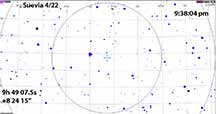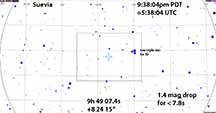


Here's my plan for the 2nd site, which I plan to man while Kirk stays at the campsite in the mtns.
from Carrizo Plain, on Astro 25 Field Astro Course trip
This favorable event coincides with our Astro 25 field trip course to Carrizo Plain National Monument. I hope to have at least 2 different stations in Carrizo from my team. Kirk and I are very likely. I'm building another occultation setup but given the short time, it looks unlikely it will be ready. We're looking to have some clouds to fight off, for Friday night, unfortunately. More on that as the date approaches.
Weather cooperated! We got data...
 |
 |
 |
Here's my plan for the 2nd site, which I plan to man while Kirk stays at the campsite in the mtns. |
Pretty good! The clouds of the day cleared away by sunset. I drove the van down to the planned spot next to Soda Lake, along with students Helen, Jacob, and Raphael. Kirk stayed at camp with the rest of the students, except Roger, who drove to the Soda Lake turnoff and set up his camera and refractor, which has a video mode. He could barely see the target star in the small refractor, and didn't get data. I got a 6 second successful recording near the centerline, and Kirk had a miss successfully recorded, so there was a north shift.
Nolthenius Results
My initial data length was 7 minutes long, and the altitude was high enough to cause noticable image rotation. I used a single tracking star for my first go, and the 'snap -to' aspect of PyMovie still worked well. However, I'd like to re-do the analysis with 2 tracking stars so it will track the target better. And also, to better coordinate the sizes of the default and adaptive apertures to reduce scatter. This may give a better idea of a suspicious single-integration drop out that might indicate a moonlet a few seconds after the actual occultation.
For My Students, some explanation...
There is software written by Bob Anderson called PyMOVIE. It's a Python language program which will analyze a .avi video file of an asteroid occultation by setting apertures around each frame's selected stars and produce an Excel file of the brightness measurements of each selected star for every frame of the video. This photometry Excel file is then input into another Python program called "PyOTE" which will do Monte Carlo simulations to determine the best estimated time of the D and R and the error bars on those timings. Both programs will produce nice light curve graphs along the way, shown below.
|
PyMovie with tracking star (blue), target star (green), and blank empty sky (red). The occultation is 6 seconds long, near the center |
PyMovie light curve of just the target star, and the aperture size for each measurement. I just took the default values, which was probably not optimal. Sharpness was good, and a much smaller default aperture would have been at least more consistent. |
This is the PyOTE light curves of the target (blue) and the tracking (= comparison) star (red). The Watec camera was set at 4x, which means 4 fields or 2 frames per integration. The camera dumps to the DV tape the total integrated light for 2 frames at a time, in other words. PyOTE will first combined those frames, reducing the number of data points to 1/2 of the un-integrated output seen in the PyMovie light curves. |
PyOTE will do 50,000 simulations of data points with the same noise statistics, and then finds the D and R times for each of these 50,000 simulations, and uses that to find the error bars on the determined D and R times. It also finds the odds that the observed dip in brightness was real, and not just random noise. With the "red bar" to the right of the "black bar", the odds that the dip was noise, is 0.00000% |
This is PyOTE's determination of the light curve around the time of the occultation, and shows the vertical red and green bars to show the D and R moments and the error distribution. Because there was some wavering in brightness in the tracking star, and that also seemed true during the occultation, I thought it best to do the target star photometry relative to the comparison star, rather than absolute brightnesses. One could try to smooth the light (black curve) with longer bandpass times and perhaps reduce noise in my times? |
My event was 6.6065 sec long, and the SNR was 2.51. The observed magnitude drop was 1.49 and the predicted drop was 1.4 magnitudes, in very good agreement. The predicted duration for a central event was 6.8 seconds, so my 6.61 seconds indicates I must have been close to the centerline. That makes it puzzling that Kirk observed a miss. That says the asteroid may be irregular and "flat" on the south side to manage to avoid hitting Kirk at our campsite.
There is a suspicious single-integration (4x or 1/15 second) drop to zero a few seconds after the actual event. I decided to test its significance in PyOTE. It failed the 'red bar/black bar' visual test, however, it might be more significant if I can use two tracking stars, given the image rotation observed during the long event taped.
|
This is the distribution of probability for such a single-integration drop such as I saw about 5 seconds after the real event. The possibility of a 'false positive' is too high to consider it real enough to report. |
I've now re-done my analysis. I followed the suggestion of software writer Bob Anderson and made the target aperture be fixed instead of a snap-to-blob, so that it follows the tracking stars, but is constantly a circle of generous size to enclose all the starlight. I also used 2 tracking stars and turned each 'yellow' to make them both tracking stars. This is what to do whenever field rotation is suspected. The results didn't change significantly. I also did not use the tracking star for a comparison star reference, but instead just did PyOTE on the raw magnitudes. It improved the accuracys of the timings, but did not change the values of the D and R. The single-integration "event" still does not come close to being 0 chance of a false positive.
|
Now there are 2 tracking stars (gold and blue). |
Target star alone in PyMovie. Some moving very slight cloud seems evident but not seriously interfering with the occultation |
This is the same tracking star as in the first analysis run. The dip is cloud, almost certainly. |
Even blank sky is darker during the cloud passage, probably because the cloud was low enough to be darker against the brighter higher skylight lit by, perhaps San Luis Obispo far away? |
Still a solid event. |
The occultation duration is identical to the first analysis. |
Bender Results
Kirk observed from our campsite, still well inside the predicted path and with high odds of a "hit". But, the path seems to have shifted north from the prediction, and the asteroid was of unusual "flat" shape on the south side, because the shadow missed our campsite... a "miss".
|
KIrk's 2 tracking stars and the target. Aside from a wind-shake or tripod leg bump at the wrong time, which shows on all 3 stars not just the dark blue target light curve, there's no evidence of an occultation. So, a miss on the southern side of the asteroid. |